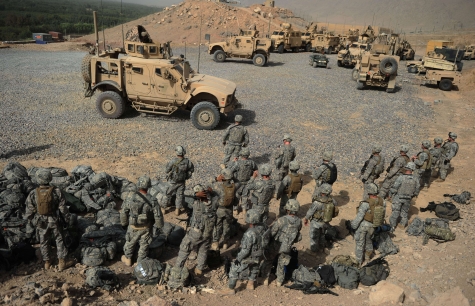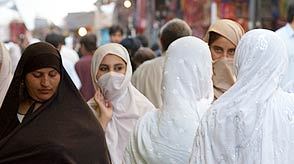Reflecting on my coverage of the latest UN report released on Tuesday showing a 31 per cent increase in overall Afghan civilians casualties, a couple of questions raised in my mind about the overall chances for success by the US-led coalition.
Number-crunchers from the UN’s Assistance Mission Afghanistan (UNAMA) now say the Taliban and other “Anti-government elements” are responsible for 76 per cent of civilian deaths logged in 2010. The increased use of roadside bombs by insurgents has plenty to do with that.
But so too does the increase in US forces President Obama has sent here since the “surge” strategy was announced last year. More fighters equals more fighting. And based on my last three embeds in the past year, there is no doubt in my mind the Taliban is winning by greeting the newly arrived troops and their first-world hardware with the easy-to-make, increasingly undetectable homemade bombs—the same form of asymmetrical warfare used with devastating effect in Iraq.
It’s unconscionable the level of Afghan civilian deaths caused by these IED’s—including a 155 per cent increase in child IED deaths in 2010 from the same period in 2009. So too are the Isaf strikes that killed 12 per cent of Afghans in the first half of this year, even though civilian casualties caused by coalition air strikes plummeted by 64 per cent.
But talking with some folks familiar with the Taliban thinking, it is even more distressing to ponder that maybe a large number of the population here just might accept the Afghan civilians killed by fellow Afghans in the name of expelling the foreign occupier.
And it’s not just foreign soldiers being gunned down, as we saw just a few days ago in the tragic case of the 10 NGO workers killed in Badakshan province (previously thought a “safer” area from insurgent attacks). Foreigners are increasingly targets—whether aid workers, private security companies, diplomats, or even us journalists.
So what if, in spite of American military hardware and domestic political fears of losing this war, there is no realistic chance of defeating the Taliban? No way of unscrambling the egg. Not getting the toothpaste back in the toothpaste container. Take your pick.
After 9 years of war, President Obama inherited a conflict that was poorly fought and under resourced. Much of the goodwill Afghans showed around 2002 has since evaporated in the wake of Isaf civilian casualties. Coupled with a tired American military—many of whom served several exhausting tours in Iraq, understood Afghanistan to be only a sideshow in President Bush’s priorities, and arrived here in no mood to strike up friendly relations in yet another tribal society they hardly understood—its more than possible to see that for many the coalition has worn out its welcome.
Thanks to this video compiled by Huffington Post, it is also clear these were worries on the prescient mind of then US Senator Barack Obama, whose rhetoric on Afghanistan and the American mission has shifted considerably since becoming Commander-in-Chief.
When asking coalition forces how they saw their mission ending, I got several different answers, almost none of which were establishing a lasting democracy here.
Never once mentioned by American G.I.’s I talked with was the “removing Al Qaeda” mantra. Even the CIA Director talked openly that Al Qaeda’s presence here might only be “50-100 fighters, maybe less”—hardly a figure that justifies over 100,000 forces. One Special Forces soldier even told me that they were there to have a presence in the event of a confrontation with neighbouring Iran. Indeed, especially long airstrips have been constructed in this country that just might allow for that contingent.
While Isaf changes leadership and muddles through problems with the many problems crippling the Karzai Government, concerns grow that this country could be heading toward civil war or splitting along ethnic lines

One senior US Army officer told me last month in Kandahar his “worst fear” of how that might happen. He said that he and his fellow officers could imagine a scenario where the Taliban captures Kandahar, the country’s second largest city, which is dominated by ethnic Pashtuns.
He said that all it would take for a “game over” scenario is for the Taliban to capture the Kandahar District Government Headquarters (which they’ve bombed and attacked in the past). And once the Taliban raises their black flag, gathers journalists, and makes their appeal to the world and United Nations for temporary statehood recognition, that some in the international community, especially European countries, who are anyhow weary of how this war is being fought from Kabul, just might concede.
I don’t know how likely that possibility is—pretty hard, I would guess, given its heavy fortification and closeness to quick reaction forces at Kandahar Air Field. But the UN also showed how assassinations of civilians and those daring to seek employment by the Afghan government increased by more than 95 per cent. That’s a statistic that can just as easily render a government building ineffective, as one that has few employees can hardly do work. That certainly hit home in the Arghandab District of Kandahar area where I was last month, as its District Governor had just been killed by the Taliban, in addition to two other senior tribal elders working with the coalition.
All of this adds up to an outcome that no one seems to be seriously debating, which has me wondering if maybe, beneath the veneer of it all, Isaf is planning an exit based on mitigating its damages, trying to bloody the Taliban nose into negotiation, and waiting for the first opportunity to get out of Dodge.
After all, it is hard to see Isaf’s strategy of “protecting the population” work, particularly if the population does not want it and is content with losing many more times Afghan civilians to drive the foreigners away.
So is the US and Isaf giving this the attention it deserves? Sadly, the only ones apart from them who may know work for Wikileaks.
